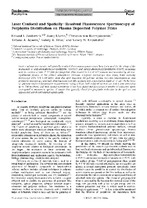| dc.contributor.author | Zenkevich, E. I. | en |
| dc.contributor.author | Martin, J. | en |
| dc.contributor.author | Borczyskowski, C. von | en |
| dc.contributor.author | Ageeva, T. A. | en |
| dc.contributor.author | Titov, V. A. | en |
| dc.contributor.author | Knyukshto, V. N. | en |
| dc.date.accessioned | 2017-05-27T10:10:32Z | |
| dc.date.available | 2017-05-27T10:10:32Z | |
| dc.date.issued | 2008 | |
| dc.identifier.citation | Laser confocal and spatially-resolved fluorescence spectroscopy of porphyrin distribution on plasma deposited polymer films / E. I. Zenkevich [et al.] // Macroheterocycles. – 2008. – Vol. 1. – P. 59-67. | en |
| dc.identifier.uri | https://rep.bntu.by/handle/data/30183 | |
| dc.description.abstract | Laser confocal microscopy and spatially-resolved fluorescence spectroscopy have been used for the study of the interaction of di(p-aminophenyl)etioporphyrin (DAPEP) and tetra(p-aminophenyl)porphyrin (TAPP) molecules with the surface of thin (7-15 μm) polypropylene films treated by 0.5 M KCl solution and activated by air non-equilibrium plasma at the normal atmospheric pressure. Confocal microscopy data (using laser scanning microscope LSM 510, Carl Zeiss) show that after treatment the polymer surface becomes inhomogeneous, and porphyrin moieties are randomly distributed on both film surfaces with a penetration depth of ~1 μm. On the basis of spatially resolved fluorescence measurements (using a home-built confocal microscope with a time resolution up to 100 ms/frame and high spatial resolution) it has been found that fluorescence spectra of individual spots correspond to monomeric species. It means that spatially closed few porphyrin molecules in the spot are not aggregated and do not interact significantly. | en |
| dc.language.iso | en_US | en |
| dc.title | Laser confocal and spatially-resolved fluorescence spectroscopy of porphyrin distribution on plasma deposited polymer films | en |
| dc.type | Article | ru |
| dc.identifier.doi | 10.6060/mhc2008.1.59 | en |

